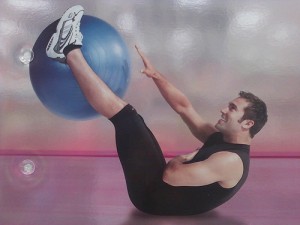by Michelle Sutton-Kerchner
The body’s core is responsible for much of our movement. When functioning well, it protects and assists in daily functions. It can alleviate pain, prevent sprains, and, yes, help us look buff in a bathing suit …
Until recently, not many ever heard of “the core.” Today, it’s a hot spot. Defined as the muscles deep within the abs and back that attach to the spine or pelvis, the core is the source of movement and stability. It helps support the spine and surrounding muscles for safe functioning. A healthy core improves physical activity, from every day functioning to running a marathon.
A workout that targets the abs strengthens the core. However, a customized core workout can zoom in on the core’s specific muscles. Although these muscles work in unison, a personal trainer or fitness instructor can help target the individual areas of the core to build this powerhouse from every angle. Core muscles include: transverse abdominis, external and internal obliques, erector spinae, and the rectus abdominis.
Protective Benefits
When core muscles are not working properly, the body suffers an imbalance. This can lead to muscle aches and stressed joints. Back pain commonly occurs. Often, the best therapy for chronic back pain is improved core functionality. Once a flare-up subsides, physicians typically recommend rehabilitative exercises that focus on the core. A strong core goes far beyond tank-shirt ready results.

Few can admit never suffering back pain. The simple acts of standing and sitting invoke myriad muscles to do the job well. Weakness in the core, poor posture, and excess weight puts a strain on the entire skeletal system. The most common outcome is a strained lower back. An optimal core better supports the spine, which reduces pressure on spinal discs. Disc injury, such as herniation or bulging, becomes less likely.
Along with potential for back pain, a weak core leaves one susceptible to falls. Without stability at the core, it is easier to lose your balance. It also weakens your body’s ability to respond to sudden moves and execute new movement without injury. Fitness professionals often suggest newcomers start a program by slowly improving the role of the core. This provides a solid foundation from which to expand a safe workout. Begin with the body’s powerhouse and work outward.
Dig Deep: Exercises for the Entire Core
The Plank: After the Center’s recent Plank-a-Palooza, some members may be familiar with the wonder that is the Plank. Versatile to adapt to abilities and restrictions, the Plank targets the deepest core muscles, the transverse abdominis. These muscles belt around the spine to aid in stability and protection.
Exercise Balls & Medicine Balls: Try sitting on one of these and immediately you will understand how they help build the core. Without any support for the back, the simple act of balancing oneself in a seated position on an exercise ball triggers core muscles to respond. A personal trainer can demonstrate ways to incorporate exercise and medicine balls into your fitness routine for the ultimate core workout.
Pilates: The core is the main focus of any Pilates workout. Pilates Manager Nikki Cifelli uses a tree trunk analogy, “Think of a tree: The stronger and better rooted the trunk (the core), the stronger the branches.” Pilates creates a long, lean, integrated body and mind through mindfully engaging core muscles. Its no-impact nature, and gentle ability to improve overall fitness, makes it a rehabilitative solution for those suffering injury. The entire body benefits, without strain, while reducing risk of future injuries from a weak core.
Pilates is able to isolate specific muscle of the core while other muscles remain disengaged. Nikki explains how larger, stronger muscles always compensate for smaller, weaker ones. During other exercises meant for the core, one often fails to engage actual core muscles, but uses pectoral muscles and hip flexors instead. During Pilates, one is taught how to identify and engage the target core muscles and disengage others, assuring more thorough and precise core work.
Exercises that challenge your balance and torso strength build a better core.

Highlights of a Core Workout:
- Improve muscle communication for fluid, efficient movement
- Reduce risk of injury
- Improve health of the lower back
- Reduce risk of falls through better balance and stability
- Improve posture
- Reduce chronic back pain
- Improve waistline
Core training results in a better athlete. Whether performing on the field or in the kitchen, strength at the core allows your best outcome. It helps correct discrepancies in movement that may inhibit activity. It also helps perfect your winning moves.
Fitness is much like the rest of life. Inside is what counts. The exterior is a bonus of goodness at the core.
Sources
“Core Strength,” by Paige Waehner at www.about.com.
Image Credits
Exercise Ball: http://www.flickr.com/photos/adriarichards/2798736890/
Exercise with Ball: http://www.flickr.com/photos/chrisdlugosz/3516053286/
Healthy field fitness: http://www.flickr.com/photos/fortcollinschiropractor/6169824540/
 Fitness & Wellness News Your Source for Fitness News, Wellness News, Health News, and Nutrition News!
Fitness & Wellness News Your Source for Fitness News, Wellness News, Health News, and Nutrition News!




